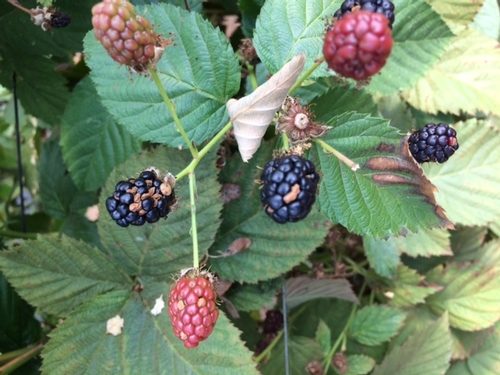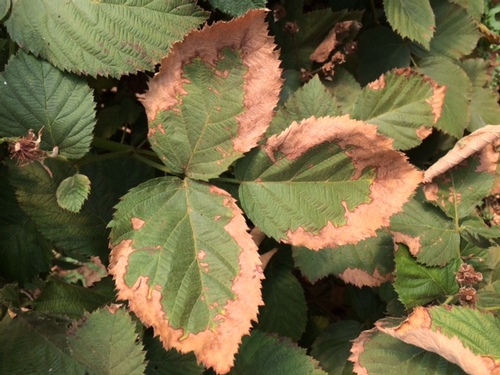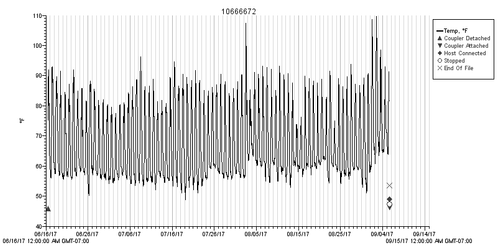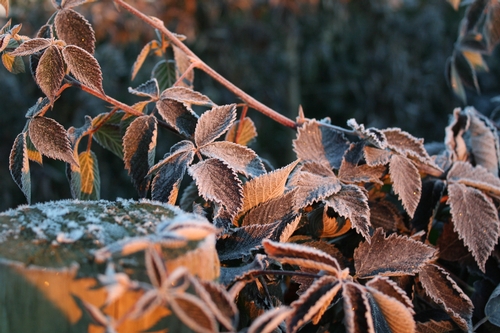
Posts Tagged: Blackberries
When Blackberries Go Wild
Ripe, juicy, sweet blackberries: what's not to love? Blackberries are grown for us to eat and...
Roasting Late Summer Heat Does a Number on Central Coast Blackberries
The savage heat of the past few weeks has really wreaked havoc on our blackberries. Normally thought of as being fairly stalwart sorts of plants, relatively easy to grow with few disease and insect issues, blackberries seem to be revealing themselves as a bit sensitive to high temperatures.
Not only are we seeing many, many cases of white druplet and subsequent necrosis (first photo), but also leaves of plants, especially at the margins (second photo), are being burned. Close readers of this space will know that white druplet is caused by intense ultraviolet radiation, and that the marginal burn of leaves probably means that the plant is not keeping up in moving sufficient water to its extremities.
Most galling however has been the large amount of red druplet disorder, better known as reversion. As one can see from the third photo below, reversion is a nuanced reddening of pretty well the whole fruit (as opposed to the starkly demarcated reddening caused by redberry mite - see elsewhere in this blog). This occurs post-harvest, meaning the fruit looks just fine at harvest and only reddens when it's been in the cooler for a bit.
It's almost certain that this fruit reddening is being caused by rapid and large changes in temperature. Research has shown that fruit with an internal temperature of over 72.5o F followed by a fairly rapid drop to cold is most likely to experience red druplet disorder. Given that in our pronounced heat spell over the past few weeks, with temperatures in production tunnels up to and even exceeding 110o F (see photo below), and movement of fruit from that environment to the mid 30's of the cooler (a drop of more than 70o F) being the embodiment of a large, rapid change in temperature, then perhaps having a huge amount of reversion shouldn't be so much of a surprise.
Ways to avoid this problem during high ambient temperatures are to avoid getting fruit that hot into the box in the first place. To whatever extent possible, early picking and quick transport to the cooler are clearly best. The other, which has been explored by researchers and may be in effect in some areas, is a staged cooling which gradually brings down the temperature to avoid the rapid shock of what forced air at 35o F imposes.

White druplet of blackberry induced by high ultraviolet light.

Blackberry leaf margins scalded by the sun and heat.

Reversion in blackberries I found at the store on September 9.

Temperatures in blackberry production tunnels taken at 30 minute intervals. Note the big spikes up to and exceeding 110 deg F.
Fresh Market Blackberry Cost and Return Study Now Available from UC Cooperative Extension
The new edition of "Sample Costs to Establish and Produce Fresh Market Blackberries Study" is now available from UCCE.
http://coststudies.ucdavis.edu/files//2013/09/30/blackberrycc2013.pdf
This is another great cost and return study in berries authored by Laura Tourte, Rich De Moura, Karen Klonsky, and yours truly.
We certainly weren't in alone in writing this study, and this work could not have been accomplished without the substantial input and contributions from local blackberry growers - thank you all!

2013 Cost and Return Study now available for fresh market blackberries on the Central Coast.
Understanding Chill for Berries in California
The cold weather we have been experiencing over the past few days has prompted a lot of talk and even articles in the popular press over what the effect of this cold would be to local berry growers. Beyond the damage that very cold temperatures could cause tender plant parts such as flowers and emerging vegetative parts (of which we fortunately don’t have very many right now), the question worth exploring is what benefit this weather could be bringing to our berry crops.
Many of our cultivated fruiting plants originate from temperate regions, including many berry species and tree fruits, and as such go dormant in response to oncoming cold weather in the autumn. This adaptation of dormancy protects the plant buds from injury when temperatures fall below freezing and the buds stay this way until enough cold has been accumulated over time.
This accumulation of cold over time, known as chilling requirement and measured in hours as chill units, is the minimum amount of cold after which many fruit trees, caneberries and strawberries need to be exposed to in order to grow properly in the following spring. The total number of hours of chill needed to establish proper flowering and vegetative growth vary substantially for plant types and even between varieties of the same plant species.
If plants requiring a certain amount of chill hours do not receive it, they may end up blooming or leafing out late in the spring or in an spread out, uneven fashion. Additionally, they may subsequently experience reduced fruit production and quality.
Another complication of calculating chill units in California, as compared to much colder regions of the country, for example Wisconsin where temperatures can be below freezing for weeks at a time (go Badgers!), is that our region tends to have a cycling of warm and cold weather throughout the winter. How then do we as agriculturalists in California calculate chill accumulation in this back and forth between cold and warm?
To calculate chill hours, there are three common models all based on the principle that plants accumulate chill between 45 degrees F and freezing (32 degrees F and not below). One model ignores the below freezing threshold and simply calculates total number of hours under 45 degrees F, another calculates number of hours between 32 degrees and 45 degrees, and another, called the Utah model, is bounded by 34 degrees and 45 degrees but also accounts for negative chill accumulation, being the understanding that temperatures above 61 degrees detract from chill hours already accumulated. It is worth pointing out that in the Utah model, temperatures under 34 degrees do not accumulate chill, nor do they detract from it.
Yet, the fluctuating temperatures of California still are a challenge to some degree for these models, and the University of California is engaged in research to get a better handle on these conditions, and is has been testing a “Dynamic Chill Model” and a “Chill Portion Model”. Both of these are beyond the scope of this blog, but Central Coast agriculturalists seeking to further their understanding about chill and how to manage it, will find an excellent resource at :
http://fruitsandnuts.ucdavis.edu/Weather_Services/chilling_accumulation_models/

7:15 am, January 13, 2013. Temperature 25 degrees F. Good morning Watsonville!

Blackberry leaves covered in frost - plus or minus benefit to the plant?

This frost covered blackberry flower will unfortunately not make it to fruiting.
Can less water grow better berries?
It might be pouring rain today, but soon enough California will be dry again. As demand for water for a growing urban population and for environmental restoration increases, farmers throughout the state are working to grow crops using as little water as possible, and UC is working with them.
"Water supplies are being constrained. Farmers are facing reduced access to water," said Shermain Hardesty, a UC Cooperative Extension specialist in the Department of Agricultural and Resource Economics at UC Davis.

The research involves using some elaborate formulas for determining how much water is needed. UCCE advisor Richard Molinar, working with small farms in Fresno County, is irrigating small plots of strawberries with different amounts of water, some at 125 percent of the normal rate, some at 100 percent, and others at 75 percent and 50 percent of normal. In San Diego County, UCCE advisor Ramiro Lobo is doing similar research on strawberries and blueberries; UCCE advisor Manuel Jimenez is working with blackberries and blueberries in Tulare County; UCCE advisor Aziz Baameur is planting strawberries and blackberries in Santa Clara County, and UCCE advisor Mark Gaskell is studying blackberries in Santa Barbara County.
Once the berries are grown, they need to be tested - and testing means tasting in this project. The research team is holding tasting sessions to let the public judge which berries they prefer. If you've ever tasted a dry-farmed tomato, you might guess the answer. The first tasting session was held at the Davis Farmers' Market in June, with seven more coming soon at farmers' markets and grocery stores around the state.
Taste is a great quality to measure, but only one aspect of the study. Berries are already known for having a high nutrient content, but growing them with less water might give them even higher nutritional value. The team expects to find nutrition density to be highest at the lowest irrigation levels. To test this concept, UCCE specialists Elizabeth Mitcham and Marita Cantwell, experts in postharvest science affiliated with the Department of Plant Sciences at UC Davis, are doing nutritional quality analysis of the berries as they are picked.

"Over-irrigation is cheap insurance, especially for such high value crops," he said.
He explained that more water tends to grow bigger berries. Since the harvest is not mechanized for berry crops, it takes as much effort to pick a small berry as a large berry, making more efficient use of the pickers' time and filling the basket more quickly if the berries are bigger.
Such a trade-off for the farmers! The public may decide that they prefer smaller berries with more taste, and the scientists may decide that smaller berries are more nutritious, but will it be profitable to grow better berries? It may depend on how much smaller, and on how much less water for how much better nutrition and taste. It may depend on the water rates, says Hardesty. She will be taking all of these variables into account to determine the potential impact on profitability of lower irrigation rates on berries.
The team, which also includes UCCE advisors Michael Cahn in Monterey County and David Shaw in San Diego, will report the results of their study to California farmers in the final year of the project. This project is funded by a California Department of Food and Agriculture Specialty Crop Block Grant.

